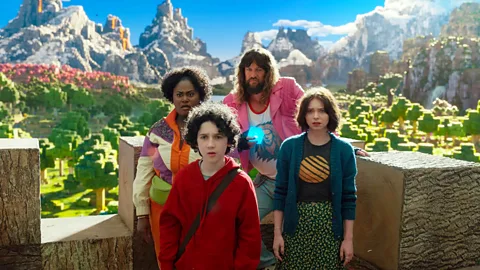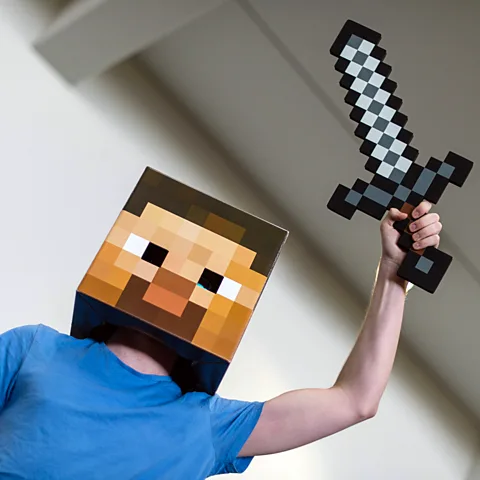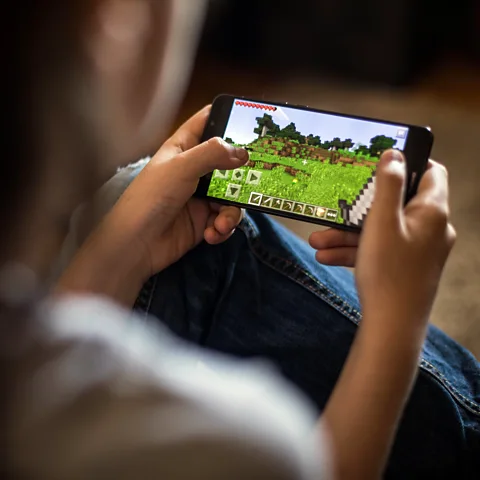Minecraft is the world’s best-selling computer game and soon to be a Hollywood film. This is why children can’t get enough of it.
AJ Minotti has three children – and they all love playing Minecraft. His twin girls aged 10 and his six-year-old son are constantly building stuff with the endless supply of virtual blocks that fill the game. And Minotti, who works in marketing in Ohio, sometimes gets blown away with what they come up with.
“Dad, I want to show you something,” one of his daughters said to him recently as she held out the screen of her Nintendo Switch. Her avatar stood before a waterfall. After pressing an in-game button, the waterfall stopped, revealing the entrance to a cave. Inside was a subterranean super-lair complete with interactive lighting and display areas for items that she had collected in the game.
“It was like this whole underground mansion, basically,” says Minotti, marvelling. “I was super impressed by it.” His daughter had followed some YouTube tutorials but also came up with much of the design herself. “It takes me back to the feelings I had when I was a kid just hacking away on a computer,” says Minotti.
Minecraft is one of the most popular video games of all time. First released in 2009, it had sold more than 300 million copies by 2023. It, and similar games including Roblox and Terraria, are enjoyed by gamers of all ages, from young children to adults.
The game seems able absorb the attention of children for up to hours at a time – no mean feat in our distraction-filled age. Some parents fear their children’s interest in Minecraft can border on obsession, or even addiction, as they struggle to tear them away from the computer screen.
Minecraft’s popularity is such that it has now spawned a highly anticipated Hollywood film called A Minecraft Movie, starring Jack Black and Jason Momoa, which is due to be released in April 2025.
There could be deep psychological – even evolutionary – factors behind the success of Minecraft and games like it, say experts. Such games tap into an innate instinct within all of us – one that underpins the success of our entire species. The desire to build.

If you think about it, children have always enjoyed making things – sandcastles, forts, treehouses – to name a few. Consider also wooden blocks, playdough and Lego pieces. Minecraft is, arguably, just a recent iteration of this kind of play, but in a digital space. But why is building things so irresistible for many children in the first place?
All mammals play when they’re young, says Peter Gray, a psychologist who studies children’s ways of learning at Boston College, in Massachusetts, US. Predatory animals, for example, play at catching things. Prey animals practise dodging and darting.
“They play at the skills that are most important for them to develop for their survival and ultimate ability to mate,” says Gray. Humans are unlike other animals in that we owe much of our survival to our ability to build stuff – from mud huts to tools for hunting and gathering. “It’s not surprising that natural selection endowed young people with a strong drive to play at building things,” says Gray.
He notes that children also play using language and imagination, or make games that have rules and social interaction at their heart – all seemingly as part of preparation for adulthood.
What youngsters choose to build during playtime, and how they build it, tends to reflect the culture they live in, says Gray. “We should not be at all surprised that kids are really drawn to playing on computers today – nor should that distress us,” he says. “Kids know in their bones, in their instincts I would say, that these are the skills [they] need to develop.”
Minecraft players tend to differ from the population at large, being substantially more curious and less driven by traits such as vengeance
Julian Togelius, a computer scientist at New York University, has noticed the impulse to build things emerging in his son – who is not even three years old. At nursery, he immediately starts making tunnels so that he can drive toy trains and trucks through them, explains Togelius. When his son gets a bit older, computers might become irresistible. Crucially, sandbox games – video games such as Minecraft that offer players the freedom to explore their creativity without any particular goal – make it easy to interact with and do things on computers, says Togelius.
“In Minecraft world, creating [something] is direct and simple,” he explains. “It’s way easier than writing code.” In other words, games like this satisfy the innate urge to build when computers, traditionally, might otherwise hinder that impulse, especially for children.
And yet constructive play isn’t the only draw. While sandbox mode in the game lets players create with freedom, there’s also Survival Mode, in which the gamer is tasked with fighting off enemies. Minotti also notes that there is a social side to the game too. When his kids can’t meet up with their friends or cousins in-person, they can do so online: “It becomes that virtual hangout space.”
Minecraft is perhaps better thought of as an arena or virtual playground within which children can find their own niche – since they can choose from a wide range of activities and play styles.
Togelius has studied how gamers’ behaviour in Minecraft reveals aspects of their personalities. He argues that, because of the freedom afforded to players, it is easier to express themselves in the game than in, say, the arcade classic Asteroids, where players shoot at incoming space rocks. As part of his study, Togelius and colleagues asked adult participants to answer a questionnaire that revealed details of their personalities. They then compared those results to how each participant played Minecraft. The participants’ in-game behaviour correlated with certain traits.
“Independence is strongly predicted by not finishing the main quest in the game,” says Togelius. Plus, people who expressed having deeply-held family values in their questionnaire responses seemed to unwittingly demonstrate that through their in-game activities. “They build little homes and fortresses with fences and stuff.” While Togelius hasn’t repeated the study with children, he says he wouldn’t be surprised if their personalities also manifested themselves in-game, too.
He also found that Minecraft players in their survey tended to differ from the population at large, being substantially more curious and less driven by traits such as vengeance.

The breadth of possibilities in sandbox games helps to ensure wide appeal, says Bailey Brashears, a psychologist at Texas Tech University, who last year published a thesis on how Minecraft can be used as a psychological research tool. Brashears identified five distinct gameplay aspects. There’s a social element, the opportunity to feel competent through combat or exploration-based play, engineering, creativity and finally survival-based gameplay.
“Most games, you’re only going to get one or two of these elements,” Brashears says. “You’ll get a game that’s mostly social play and survival – like Fortnite,” she says.
Of course, the amount of time children spend playing Minecraft speaks to wider concerns around how much screen time they are getting in general. (Read this article by Melissa Hogenboom about why not all screen time is the same for children.)
But Minotti stresses that his children have varied playtime – they love outdoor activities such as basketball, as well as video games. But sometimes, he has to remind them not to play video games excessively and he also steps in to approve any online friend requests. “We don’t just set them free on the internet,” he adds.
The NSPCC, a children’s charity in the UK, has published advice on how to keep kids safe when playing Minecraft and games like it. There have been serious cases of child grooming and abuse in Minecraft. The chief executive of Roblox also recently sparked a fierce debate after saying parents should keep their children off his company’s gaming platform if they are worried about them being exposed to harmful content through its games.
Overall, Minotti is comfortable with the fact that his children spend plenty of time in Minecraft because he says he has clear oversight of what they’re doing and because they use it so creatively. “It’s basically just a digital playground,” he says.

Minecraft’s broad appeal also means it provides an opportunity to connect with people in new ways. University professors, for example, used Minecraft to carry out online learning sessions during the early years of the Covid-19 pandemic. And primary school teachers in Ireland have reported success in engaging entire classes of pupils via Minecraft Education – a version of the game designed for classroom activities – says Éadaoin Slattery, a lecturer in psychology at the Technological University of the Shannon Midwest. Her research, featuring interviews with 11 teachers in Ireland, was funded by Microsoft, which owns Minecraft.
Slattery mentions one example of a teacher who decided to set up a game within Minecraft Education to help his students learn Gaelic. “He talked about creating restaurants and different food in Minecraft – this would help the students learn different words,” she says.
Separate research has found that using Minecraft in classrooms can heighten pupils’ motivation for school tasks, problem-solving, reading and writing, among other skills. Perhaps educational activities in Minecraft are taking advantage of the “flow state”, or high level of concentration and focus, that players enter when they become deeply engrossed in the game. This phenomenon is associated with lots of different activities but it is so prevalent among Minecraft fans that it has made them the subject of study. It is part of the reason why children can become so absorbed in the game while ignoring everything else that is going on around them.
That said, there is evidence that Minecraft is not universally engaging, and may have a gender imbalance. One study in Australia, which surveyed more than 700 parents, found that while 54% of boys aged three to 12 played Minecraft, only 32% of girls in that age group did. The study authors say that it is important for games and online platforms to engage girls just as much as boys – since those games help kids to develop the digital skills they will need later in life.
AJ Minotti, for one, is not worried about his daughters struggling to get to grips with computers. “Minecraft really has become their thing,” he says. “I have to ask them what’s going on.”
And while his kids also enjoy making things with physical Lego bricks, for example, Minotti says they don’t have room to store a tonne of Lego pieces at home. In the end, Minecraft offers an easy solution. “It’s just having all the Lego pieces you could ever imagine,” he says.













